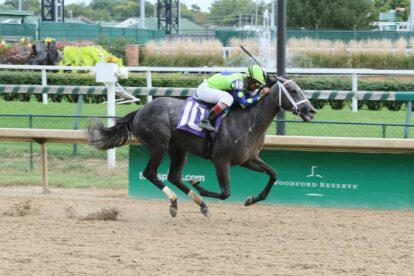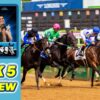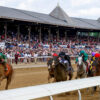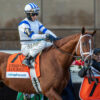One of the toughest things to do when handicapping horse racing is consistently picking winners in 2-year-old maiden races. You’ll often run into big fields but with little or no experience to help you form your opinion.
Some people choose to stay away from these races, but I absolutely love them. In many of my large scores, including my three largest this year, 2 year olds maidens have been the key. I was able to either single (a 2-1 at Gulfstream in a Pick 5) or go two-deep and nail a 15-1+ horse where others were playing 4-5 horses on similar sized tickets.
This is in no way a comprehensive list of angles that you can look for, but it will allow you to decipher more than just workouts on the page.
Let’s start with horses making their debuts:
Trainer Percentages
- Many people will lean on these numbers, and while they are important to take into account, do not rely just on the First Time Starter numbers. For instance, trainer Todd Pletcher is 24% over the last 5 years with first timers, but his median payoff is only $5.00 on those winners, or 3/2 off odds. I generally will not play a Pletcher first time out if the horse is not getting bet, which leads us to…
The Odd Board
- This is a GREAT source of information for maiden races. People specialize in these by heading out every morning to watch workouts. If a horse gets bet down from a 10/1 morning line to 3/1 or 5/2, more often than not, that horse is live. A great habit of mine is writing down the odds of each horse every five minutes under the morning line because it highlights patterns. Remember, the early money and the late money are normally the smart money.
Specialist Trainers
- Most first timers race between 4 1/2 and 6 furlongs on the dirt, but when they don’t then I will look for a trainer who excels at the conditions. Sometime trainers, even the best in the world, are simply better over a surface, at a distance, or with a specific sex. I’ll use Linda Rice, since she fits this angle well. Rice simply knows how to train turf sprinters so I will normally use a Rice horse first out turf sprinting. When you have first time starters going over a mile on turf, over a mile on dirt, or sprinting on the turf, I pay specific attention to a trainer’s stats at those conditions.
Purchase Price
- People are in racing to make money, so I am looking for horses that sold for big numbers. Now, when I say that, I am not specifically talking about purchase price. Obviously, I will give a long look to a horse that sold for $1.2M, but those are often by major sires like Tapit, who stands for $300k. That would make its stud-to-sale ratio 4:1 (1.2M divided by 300k). I am very interested in that specific ratio, especially if the horse was bought as at age 2. Here’s an example from Belmont’s fifth race on September 19, 2018:
- #2 Strive for a Cure
- Goldencents Stud Fee: $12,500
- Sold For: $9,000
- Stud-to-Sale Ratio: 9,000:12,500 or 0.75:1
- #9 Funny Guy
- Big Brown Stud Fee: $6,000
- Sold For: $45,000
- Stud-to-Sale Ratio: 45,000:6.000 or 7.5:1
- In this instance, I am going to give Funny Guy a long look. Generally anything with a stud-to-sale ratio of over 5:1 catches my eye, and over 10:1 is solid.
- #2 Strive for a Cure
- Take note of the year of the sale as well. If they are bought in the spring of their 2-year-old year (like both of the horses above, which were EASMAY18 and OBSAPR18), it generally means that the horses were worked out over 1-2 furlongs in front of potential buyers. When a horse goes for a high ratio as a 2-year-old off of a lower stud fee, then you can expect to see early speed. The faster you are, the more you sell for.
Now let’s look at 2-year-old angles that can apply to both first time starters and horses with a race or two under their belts:
Sires
- This angle is often as simple as knowing that, if the parents were good over a surface or distance, then the offspring will be, too. You’ll also see that with sires who raced well as juveniles. City Zip was a very good 2-year old who showed speed, and many of his offspring have replicated that. I specifically pay attention to foals’ second time out when they are moving to the surface that they should prefer. For instance, if I see a War Front run first out on dirt and then enter on turf, then I project a great improvement. It is often the same when you go from sprinting first out to a route. The sprint is used as a glorified workout to get the horse some experience before running where it should excel.
Second Sires
- I love this angle since it’s not nearly as widely used. It’s extremely important to look at the grandfather and factor in his specialties. If you listen to The Magic Mike Show, then you know that I love The Factor and Violence as sires. Declaration of War is another one that fits, but I don’t mention him as often. Each of these horses stand for a fraction of their fathers’ stud fees, but their offspring have already displayed a ton of talent with their grandfathers’ specialties. Here’s the breakdown:
- The Factor stands for $17,700 (by War Front, who stands for $250,000)
- Declaration of War stands for $25,000 (by War Front)
- Violence stands for $25,000 (by Medaglia d’Oro, who stands for $250,000)
- Bonus Second Sire – Verrazano, who stands for $17,500 (by More Than Ready, who stands for $75,000)
- His dirt horses (where he was best) have not looked good, but on turf, he’s piqued my interest. More Than Ready has been a great turf sire, so even though Verrazano ran on dirt, he has turf performance in his bloodlines. Right now, you can get prices on Verrazano first timers on turf. Keep an eye out and see if you can find any more second sires that are running hot.
Speed and Fade
- Often, a horse will bolt out of the gate and get tired the first time it runs. I’ll generally look to play those horses back, especially if they are facing a weaker field second time out. It’s important to remember that how much they fade is largely irrelevant. Many 2-year-olds will flat give up if they make the lead first time out and then get passed, so it’s not common to see a horse break on top, set the pace, and lose by 20 lengths just to wire the field second time out.
Second Time Out
- This is probably the most basic, but it’s completely logical. Anytime a horse does something for the second time, it has the right to improve. In its first start, everything is new. The second time, it knows what to expect and understands what it is about to do. Doing everything for the second time is often when you see the greatest improvement. Remember, this applies to second time around two turns and second time on the turf.
Equipment Change
- But ONLY one! If a horse adds blinkers, is first time Lasix, or is gelded, then I give it a positive bump. When you change one aspect on a horse, you want to see what the result will be with that change. When a horse adds blinkers, is gelded, and is switching surfaces, then I always stay away. I see it as a clear sign that the connections are throwing darts and hoping to hit a bullseye instead of making calculated adjustments.
Fifth Date Rule
- This one is my own, so take it with a grain of salt, but once a horse has run four times, I’m generally done projecting improvement unless something drastic has changed. The one exception is if the horse is running in a Maiden Claimer for the first time or making a major drop in the MCL ranks (I’m talking $60k to $20k).
I could keep going on about things that will lead me to a horse in these type of races, but this is a great start. Don’t be shocked if you see a Part 2 of this, since many people struggle with maidens, especially when they are starting out.
One last thing to remember: speed. When in doubt, you want the horse that will be running first at the top of the lane. Juveniles are green and are still learning, so they often have trouble passing horses, especially at lower levels.
Good luck at the races!











